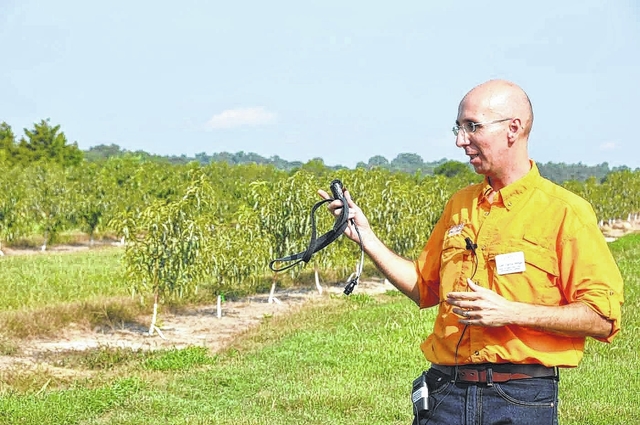SENECA — South Carolina peach growers could extend the life of trees infected with Armillaria root disease by using a new planting technique on display at Clemson University’s Musser Fruit Research Center.
By planting trees in shallow engineered berms with the top parts of the roots exposed above ground, growers can prevent the devastating fungus commonly known as “oak root rot” from progressing, said Clemson plant pathologist Guido Schnabel. The fungus can’t live above the soil line because it doesn’t tolerate extreme temperatures.
Schnabel showed off the planting technique during the annual Musser Fruit Research Center Field Days in Seneca. Fruit growers from across the state visited the 240-acre research facility where fruit scientists are discovering ways to help improve yields and reduce costs.
The farm is home to more than 350 trial varieties of peach trees, including dwarf trees that could dramatically reduce harvest labor costs because of their smaller size.
The trial varieties are tested for their performance in the South Carolina environment, specifically for yield, crop density and disease resistance and their fruit is tested for flavor, juiciness, weight and acidity. The data is then uploaded to an online database where growers can see for themselves and make research-based decisions about what trees perform best.
Greenville County Medical Examiner and forensic pathologist James Fulcher took part in field day activities with his father-in-law, Tom Jancaitis of Elberton, Ga. Fulcher grows fruit on a one-acre plot in Greenville County and Jancaitis raises cattle and grows wine grapes.
“The volume and scale of the research being performed here at Clemson is very impressive,” Fulcher said. “This is a huge resource for anyone who wants to grow fruit. Clemson has its eye on the ball of helping commercial growers feed the world.”
“We are already discussing how we can use that engineered berm system to prevent oak root rot in our trees,” Jancaitis added.
Fruit growers also heard about Clemson peach breeder Ksenija Gasic’s efforts to develop new peach varieties with improved fruit quality and disease resistance, especially for brown rot and bacterial spot resistance, one of the most destructive diseases in peaches and other stone fruits, such as apricots, cherries and plums.
Gasic, pomology professor Greg Reighard and Schnabel teamed up to work on Armillaria root rot resistance in peaches.
“We are doing everything we can to speed up resistance testing,” Gasic said. “Right now it takes seven to eight years to see the effect of Armillaria in the field, and it can take 15 to 20 years from the time of genetic cross to the time the rootstock is released to growers.”
Reighard discussed findings from peach rootstock trials. Reighard serves as a peach rootstock coordinator for a multistate project that replicates rootstock trials in different states in the U.S., Canada, Mexico and Chile. Reighard also showed growers an apple rootstock trial at the farm.
Clemson pomologist Juan Carlos Melgar showed off new sensor technology that can measure tree water movement and perform continuous monitoring of tree water status. The sensor is wrapped around the tree trunk and the data can be correlated with sensors that measure soil moisture to increase water use efficiency and optimize irrigation scheduling.
South Carolina growers harvest more than $64 million in peaches a year, according to figures from the National Agricultural Statistics Service. That puts South Carolina second only to California in peach production, federal data shows.
But field day participants got a taste of more than just peaches. Pawpaws were aplenty, and Schnabel and Spartanburg County Cooperative Extension agent Andy Rollins presented research into commercial blackberry production in South Carolina.
“There are currently two large contractors growing blackberries in Spartanburg County,” Rollins said. “We think growing blackberries has the potential to extend the market for fresh fruit further into the fall.”




